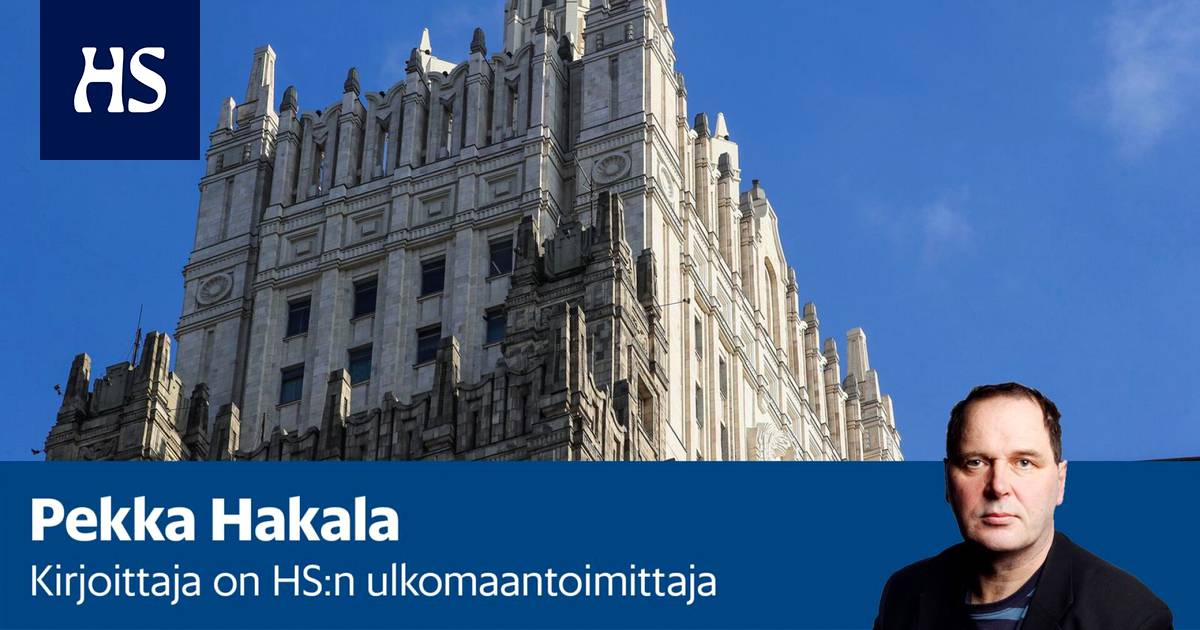Fortunately, the line papers twisted by the officials have not told anything about the future, at least in the past, writes Pekka Hakala, HS’s foreign editor.
Russian the Ministry of Foreign Affairs published a new one on Friday foreign policy strategy, according to which Russia is ready to use its armed forces not only to defend itself but also its allies and the self-defined “Russian world”. Among other things, the most important tasks in the strategy are “combating Russophobia” and “fighting for historical truth”.
Read more: At the center of Russia’s new strategy is “the fight against Russophobia and the fight for historical truth”
The clerks who drafted the text in the courtyard of the Ministry of Foreign Affairs’ tower block on the western edge of Moscow’s park ring reached downright poetic proportions in places.
“In the name of cooperation that adapts to the realities of the multipolar world order, Russia pays special attention to removing the remnants of the dominance of the United States and other unfriendly states from international relations,” the 42-page strategy paper says.
Attention is also promised to “creating conditions in which any state can refuse neo-colonialism and hegemonic ambitions”.
“The West is an existential threat to Russia”, Foreign Minister Sergei Lavrov said at the publication of the work.
Previous Russian foreign policy strategy was already more than six years old. President Vladimir Putin confirmed it by his signature on November 30, 2016.
A Russian news website operating in exile in Latvia Medusa dug out the old paper and took a few excerpts from it on his page on Friday evening.
“Russia is interested in developing versatile political, economic, cultural and spiritual relations with Ukraine,” the 2016 strategy paper says.
“On the basis of mutual respect and taking into account the national interests of both parties.”
In the new strategy, Ukraine is not mentioned except when the Russian attack is justified by “defending vital interests in the direction of Ukraine”.
“Russia is interested in the normalization of relations with Georgia to the extent that the Georgian side is ready, taking into account the prevailing political facts in the Caucasus,” the old strategy defines.
Georgia is not mentioned in the new paper, but Lavrov ominously compared Georgia’s March protests to the Maidan protests in Kyiv.
“Visa regulations are still one of the fundamental obstacles to the development of relations between Russia and the EU,” complains in the old policy.
“The gradual removal of visa regulations would significantly strengthen cooperation between Russia and the EU.”
More than a year ago, Russia defined all EU member states, including Finland, as “unfriendly states”.
“Russia emphasizes importance of Russia-US Strategic Arms Limitation Treaty,” the 2016 paper says.
Presidents Barack Obama and Dmitry Medvedev signed the so-called New Start agreement in April 2010. Putin announced in February that Russia would “suspend its participation” in the agreement.
“Even if they are just words, to be honest, it makes me cry when I read what Russia declared less than seven years ago,” Meduza commented on the difference between the declarations.
“
Ukraine is not mentioned in the strategy except when the Russian attack is justified.
Strategy declarations the comparison shows how enormous a change Russia’s foreign policy has experienced in a few years. The country and the people themselves may not have gone through such a big and fast upheaval, because all the features of today’s Russia were already visible in 2016 and much earlier.
Ukraine’s pro-Western presidential candidate Viktor Yushchenko the poisoning in 2004 and the war in Georgia in 2008 already showed that the same means are used outside and inside the borders of Russia and the nationality of the victims does not matter. Not to mention the occupation of Crimea and the start of the war in eastern Ukraine in 2014. That year, the television news and current affairs staff seemed to have sunk into imperialist war psychosis, while a large number of ordinary people remained sane.
Inside the walls of the Kremlin, however, the pretense has been stopped once and for all, when the direct line towards fascism has been chosen. When did this happen?
Putin was elected to his fourth or actually already fifth presidential term in March 2018. Two years later, on March 10, 2020, Putin appeared at a session of the lower house of parliament, or the Duma, and announced that he would accept the constitutional amendment, which practically allows him to lead Russia as long as he likes.
The policy change visible in the comparison of the strategy papers apparently took place sometime between March 2018 and March 2020.
Fortunately, the Russian Foreign Ministry’s new strategy paper almost certainly has the same flaw as the old one: it doesn’t say anything about the future.
#Analysis #Russias #foreign #policy #strategy #turned #bloodthirsty





/s3/static.nrc.nl/wp-content/uploads/2024/04/web-2604buisolskyi.jpg)

